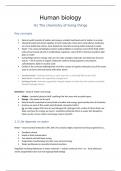Human biology
H1 The chemistry of living things
Key concepts
Natural world consists of matter and energy, smallest functional unit of matter is an atom
Chemical bonds link atoms together to form molecules, these form naturally bcs molecules
are more stable than atoms, most important naturally occuring stable molecule is water
Water = the universal biological solvent (oplosmiddel), it comprises most of the fluid within
cells and surrounds all cells in multicellular organisms, most of life’s chemical reactions take
place in water
Living things harness energy and use it to make complex molecules not otherwise found in
nature -> the 4 classes of organic molecules made by living organisms are proteins,
carbohydrates, lipids en nucleic acids
Carbon is the common building block of all four classes of organic molecules; bcs of the many
ways it can form chemical bonds with other atoms
Covalent bond = sharing electrons so each atom has a maximally filled outer shell
Ionic bond = between two oppositely charged ions
Hydrogen bond = between oppositely charged regions of molecules that contain covalently
bonded hydrogen atoms
Chemistry = study of matter and energy
Matter = (materie) physical stuff, anything that has mass and occupied space
Energy = the power to do work
Natural world comprised of same kinds of matter and energy, governed by laws of chemistry
Humans are part of this world and intimately connected with it
Eg. we take oxygen (02) from air and nitrogen (N), hydrogen (H 2), carbon (C) from food, our
body use these for energy we need + sometimes eliminate them as waste into biosphere,
when we die, all our matter and energy returns to Earth
1.3 Life depends on water
Water = most essential molecule to life, 60% of our body weight, important to living organisms bcs…
Excellent solvent
Liquid at body temperature
Can absorb and hold heat energy
Evaporation (verdamping) of water uses up heat energy
Water participates in essential chemical reactions
Ongelijke verdeling elektronen in water molecule => polaire molecule met + en – kant (elke kant
wordt aangetrokken door ion met tegengestelde lading)
, Water is the biological solvent
Solvent = liquid in which other substances dissolve (oplosmiddel)
Solute = any dissolved substance
Water is an ideal solvent in living organisms because it is a polar liquid at body temperature, solvent
of life, substance in which many chemical reactions take place
Eg. Table salt (NaCl) consists of regular, repeating pattern of sodium and chloride ions held together
by ionic bonds, when placed in water, individual ions of Na+ and Cl- are pulled away from the crystal,
breaking the ionic bond, and are immediately surrounded by the polar water molecules (oriented by
opposits attract), which form such a tight cluster around each ion that they are prevented from
reassociating back into the crystalline form => water keeps the ions dissolved
Hydrophilic molecules = polar mol that are attracted to water and interact with it easily, water loving
Hydrophobic molecules = nonpolar, neutral molecules that don’t interact easily with water and
generally will not dissolve in it, water fearing
Eg. When water and oil mix, the water molecules form hydrogen bonds (waterstofbruggen) with
each other, excluding the oil from regions occupied by water, over time the oil is forced together into
larger and larger drops until it is separated from the water completely
Water is a liquid at body temperature
Between 0°C and 100°C (liquid) : there is just enough heat energy in water to temporarily break some
of the weak hydrogen bonds (waterstofbruggen) between water molecules, new hydrogen bonds will
soon re-form with other nearby water molecules, but the pattern of bonding between neighbouring
water molecules is seemingly random
Below 0°C (ice) : not enough heat energy anymore to break the hydrogen bonds between water
molecules, they orient themselves into a stable, unchanging lattice (rooster) structure
Above 100°C (gas) : all hydrogen bonds between neighbouring water molecules are broken
completely and water molecules escape into the atmosphere as a gas, water vapor (needs energy)
Water is a liquid at body temperature => perfect medium for transporting solutes trough our bodies
Blood (90% water, rest is salts etc bcs we come from the seawater) : transport is primary function in
out cardiovascular system: under pressure generated by the heart, blood transports oxygen and
nutriens to all living cells and cellular wastes (CO2) away from the cells
Water is main constituent of all of the fluid-filled spaces in our body: it fills our cells (intracellular
space), spaces between cells (intercellular space), and others such as urine, watery solutions for
digestive system, our eyes => these fluids contain important dissolved solutes and solids as well
Water helps regulate body temperature
Water can absorb or hold a large amount of heat energy with only a modest increase in temperature
=> absorb: prevents large increases in body temperature when excess heat is produced




